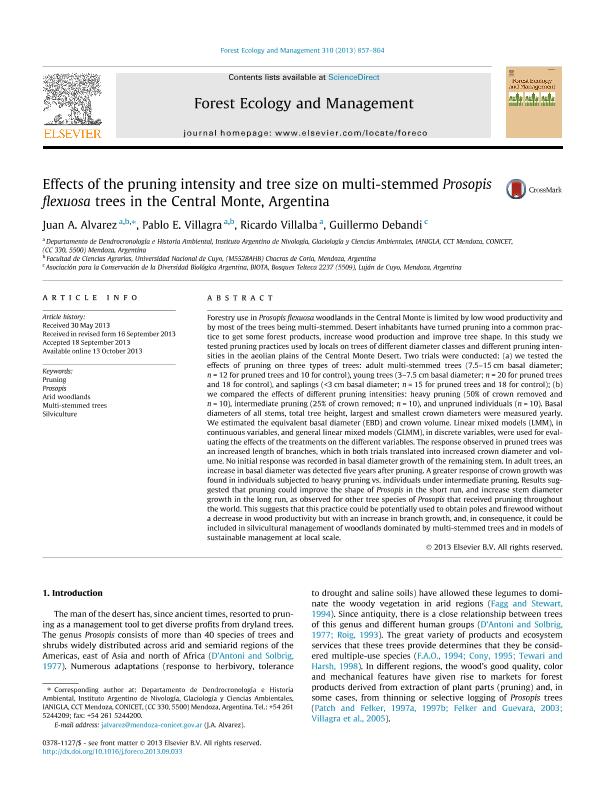Mostrar el registro sencillo del ítem
dc.contributor.author
Alvarez, Juan Agustin

dc.contributor.author
Villagra, Pablo Eugenio

dc.contributor.author
Villalba, Ricardo

dc.contributor.author
Debandi, Guillermo
dc.date.available
2015-10-01T19:52:01Z
dc.date.issued
2013-12-15
dc.identifier.citation
Alvarez, Juan Agustin; Villagra, Pablo Eugenio; Villalba, Ricardo; Debandi, Guillermo; Effects of the pruning intensity and tree size on multi-stemmed Prosopis flexuosa trees in the Central Monte, Argentina; Elsevier Science; Forest Ecology And Management; 310; 15-12-2013; 857-864
dc.identifier.issn
0378-1127
dc.identifier.uri
http://hdl.handle.net/11336/2280
dc.description.abstract
Forestry use in Prosopis flexuosa woodlands in the Central Monte is limited by low wood productivity and by most of the trees being multi-stemmed. Desert inhabitants have turned pruning into a common practice to get some forest products, increase wood production and improve tree shape. In this study we tested pruning practices used by locals on trees of different diameter classes and different pruning intensities in the aeolian plains of the Central Monte Desert. Two trials were conducted: (a) we tested the effects of pruning on three types of trees: adult multi-stemmed trees (7.5–15 cm basal diameter; n = 12 for pruned trees and 10 for control), young trees (3–7.5 cm basal diameter; n = 20 for pruned trees and 18 for control), and saplings (<3 cm basal diameter; n = 15 for pruned trees and 18 for control); (b) we compared the effects of different pruning intensities: heavy pruning (50% of crown removed and n = 10), intermediate pruning (25% of crown removed; n = 10), and unpruned individuals (n = 10). Basal diameters of all stems, total tree height, largest and smallest crown diameters were measured yearly. We estimated the equivalent basal diameter (EBD) and crown volume. Linear mixed models (LMM), in continuous variables, and general linear mixed models (GLMM), in discrete variables, were used for evaluating the effects of the treatments on the different variables. The response observed in pruned trees was an increased length of branches, which in both trials translated into increased crown diameter and volume. No initial response was recorded in basal diameter growth of the remaining stem. In adult trees, an increase in basal diameter was detected five years after pruning. A greater response of crown growth was found in individuals subjected to heavy pruning vs. individuals under intermediate pruning. Results suggested that pruning could improve the shape of Prosopis in the short run, and increase stem diameter growth in the long run, as observed for other tree species of Prosopis that received pruning throughout the world. This suggests that this practice could be potentially used to obtain poles and firewood without a decrease in wood productivity but with an increase in branch growth, and, in consequence, it could be included in silvicultural management of woodlands dominated by multi-stemmed trees and in models of sustainable management at local scale.
dc.format
application/pdf
dc.language.iso
eng
dc.publisher
Elsevier Science

dc.rights
info:eu-repo/semantics/openAccess
dc.rights.uri
https://creativecommons.org/licenses/by-nc-sa/2.5/ar/
dc.subject
Pruning
dc.subject
Prosopis
dc.subject
Arid Woodlands
dc.subject
Multi-Stemmed Trees
dc.subject
Silviculture
dc.subject.classification
Otras Agricultura, Silvicultura y Pesca

dc.subject.classification
Agricultura, Silvicultura y Pesca

dc.subject.classification
CIENCIAS AGRÍCOLAS

dc.title
Effects of the pruning intensity and tree size on multi-stemmed Prosopis flexuosa trees in the Central Monte, Argentina
dc.type
info:eu-repo/semantics/article
dc.type
info:ar-repo/semantics/artículo
dc.type
info:eu-repo/semantics/publishedVersion
dc.date.updated
2016-03-30 10:35:44.97925-03
dc.journal.volume
310
dc.journal.pagination
857-864
dc.journal.pais
Países Bajos

dc.journal.ciudad
Amsterdam
dc.description.fil
Fil: Alvarez, Juan Agustin. Consejo Nacional de Investigaciones Científicas y Técnicas. Científico Tecnológico Mendoza. Instituto Argentino de Nivologia, Glaciologia y Ciencias Ambientales; Argentina. Universidad Nacional de Cuyo. Facultad de Ciencias Agrarias; Argentina
dc.description.fil
Fil: Villagra, Pablo Eugenio. Consejo Nacional de Investigaciones Científicas y Técnicas. Científico Tecnológico Mendoza. Instituto Argentino de Nivologia, Glaciologia y Ciencias Ambientales; Argentina. Universidad Nacional de Cuyo. Facultad de Ciencias Agrarias; Argentina
dc.description.fil
Fil: Villalba, Ricardo. Consejo Nacional de Investigaciones Científicas y Técnicas. Científico Tecnológico - Conicet - Mendoza. Instituto Argentino de Nivologia, Glaciologia y Ciencias. Ambientales; Argentina
dc.description.fil
Fil: Debandi, Guillermo. Asociación para la conservaciòn de la diversidad biológica argentina; Argentina
dc.journal.title
Forest Ecology And Management

dc.relation.alternativeid
info:eu-repo/semantics/altIdentifier/doi/http://dx.doi.org/10.1016/j.foreco.2013.09.033
dc.relation.alternativeid
info:eu-repo/semantics/altIdentifier/url/http://www.sciencedirect.com/science/article/pii/S0378112713006476
Archivos asociados
